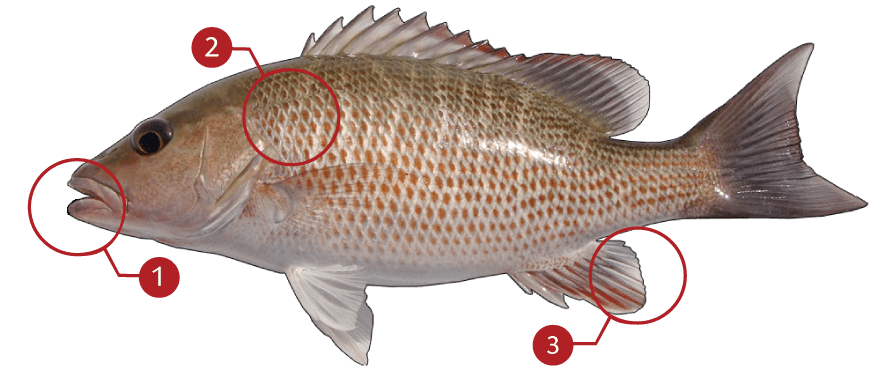MANGROVE SNAPPER
How to identify a Mangrove Snapper
The mangrove snapper has a relatively slender body, a large mouth, and a pointed snout. The anal fin is rounded and the pectoral fins short, not reaching the anal fin. Young cubera snapper may be easily confused with mangrove snapper and careful comparison of the vomerine teeth (found on the roof of the mouth) of either species is the most reliable means of discerning the two. Adult cuberas however, are among the very largest of snapper species, obtaining lengths as great as 5 feet and weights of 125lbs and such specimens are not likely to be confused for the smaller mangrove snapper. Male and female mangrove snapper are externally indiscernible.Although the general ground color for this species may vary, especially in the case of juveniles, in general the body and fins of mangrove snappers are gray to green with a reddish tinge. There are also rows of small reddish to orange spots on the sides of this species. The median fins are darker than the paired fins, often edged with yellow or white and the pectoral fins are colorless. The back edge of the anal fin is rounded. There is no black spot on the side of body. Young mangrove snappers have a prominent dark stripe from the snout through the eye and a less conspicuous blue stripe on the cheek, below the eye. They may also at times show a lateral pattern of narrow pale bars on the body. The fins of juveniles are reddish-orange with dark edges.
Where to catch Mangrove Snapper
Mangrove snapper are one of the most abundant species of snapper throughout their range, which includes the southern half of the eastern United States coast and Bermuda south to Rio de Janeiro, Brazil, and the entire Gulf of Mexico and the Caribbean. They are found in a variety of habitats, which includes inshore seagrass beds and mangrove lagoons, but the largest species are located on offshore reefs and wrecks.
IDENTIFICATION

| |
Slender body, a large mouth, and a pointed snout |
| |
Gray to green with a reddish tinge with rows of small reddish to orange spots on the sides |
| |
Back edge of the anal fin is rounded |
TARGET AREAS
|
|
Acknowledgements: We thank TAKEMEFISHING.org (www.takemefishing.org), Wisconsin Department of Natural Resources, Indiana Department of Natural Resources for their contributions to these FISH FACTS.

